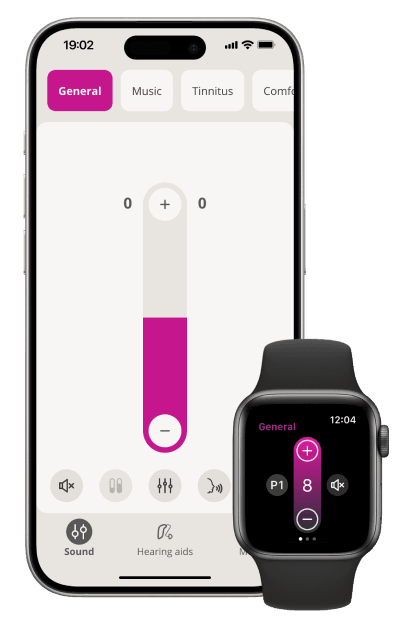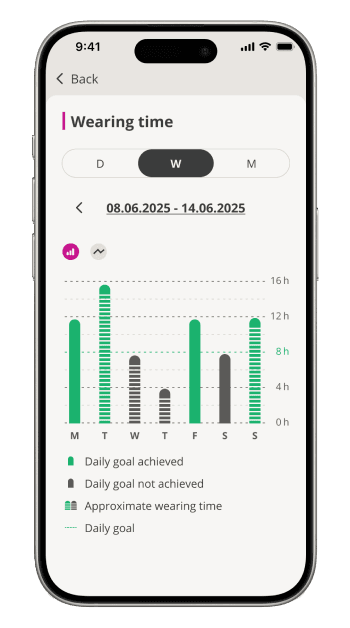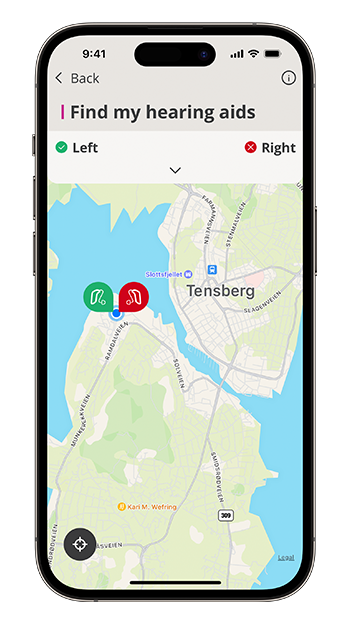![]()
Industry
Healthcare
Organization Size
Corporation (10,000+ employees)
Country/region
Denmark
Technology
Company
Demant is a Danish hearing healthcare group with more than 120 years of heritage of care, health and innovation. From pioneering early electronic hearing aids to modern digital hearing solutions, Demant's ambition is as the leading hearing healthcare company to improve as many lives as possible.
Today, Demant operates in 130+ countries with more than 22,000 employees under renowned brands such as Oticon, Bernafon, Interacoustics and Audika. One of Demant's latest innovations is the Oticon Companion mobile app, a smartphone application that lets users control their hearing aids directly. By embracing .NET MAUI and Azure, Demant built a cross-platform app that empowers hearing aid users like never before while streamlining development with a single shared codebase for iOS, Android and even sharing code with a WPF app.



Real people, real impact
At its heart, Demant's story is about creating life-changing differences through hearing health. Consider a person with hearing aids trying to have a conversation with friends in a noisy café. Before, they might struggle with tiny buttons on the hearing aids. Now, with the Oticon Companion app on a smartphone, they can easily dial down background noise and boost speech in seconds using a simple on-screen control.
The passion behind this app comes from Demant's own people who understand the importance of hearing in daily life. Demant's team includes audiologists, engineers and product experts all working together to create an ecosystem of hearing solutions from the hearing aids themselves to the fitting software used by professionals, and now this user-facing mobile app.
"This mobile app is their companion in daily life,"says Diana Pardyl, Demant's Product Manager for the app, noting that even though modern hearing aids automatically adapt to many situations, users want the ability to personalise the sound on the fly. The Companion app was designed for exactly that: user empowerment.
This mobile app is their companion in daily life"
For example, the user can easily switch modes with the tap of a button, but more tech-savvy users can dive into advanced features like an equaliser for ambient sound or streamed music, making fine adjustments to suit their preferences. "Everyone has a smartphone now… so having a big screen to easily change programs and adjust volume is extremely convenient," says Diana.
As a testament to their dedication, during development, Demant's engineers even staged a test of the "Find my hearing aids" feature: one developer buried a hearing aid in beach sand, on an actual beach, and successfully located it using the app during a live demonstration, proving that the feature works even under extreme real-world conditions!
Another useful feature is Remote Care that lets a user video-chat with their hearing care professional and have their hearing aids adjusted remotely through the app. When an in-person clinic visit is not possible, Remote Care meant hearing issues could still be addressed for thousands of users.
Even till this day, this feature is a benefit for anyone who lives far from an audiologist or has mobility issues; they can get follow-up care without traveling. These stories, from everyday convenience like quick volume tweaks, to critical support like remote adjustments, show why the Demant team is so invested in the project. They're not just building an app; they're improving quality of life for people with hearing loss.
Better together - solving it with .NET MAUI
To serve its global user base effectively, the Oticon Companion app needed to be available on both iOS and Android, offer a rich set of features, and interface reliably with specialised Bluetooth hearing aids, all while meeting strict medical reliability standards. Demant also has existing desktop software (for audiologists to program the hearing aids) and backend cloud services.
Demant wanted to deliver a unified app that brought advanced capabilities from the fitting software to mobile. Because hearing aids operate under strict on-device resource budgets (memory, compute, and power), most of the stack must run off-device and requires more than 200,000 lines of logic. Rewriting that logic separately for iOS and Android would have more than doubled implementation and QA effort, increased the risk of platform drift and defects, and driven costs up. At the same time, Demant needed to support all existing users - from legacy hearing aids to the newest hearing aids - while ensuring a seamless, consistent experience across platforms. A cross-platform .NET architecture was the clear choice.
Demant chose .NET MAUI as the backbone for the mobile app, enabling one team and one codebase to target both iOS and Android. This decision immediately paid off in development efficiency and consistency. ".NET was the only choice allowing us to reuse components across mobile, desktop and cloud. That was the key factor, making our maintenance and testing effort less in the long term," says Damian Antonowicz, Principal Architect at Demant.
With MAUI, the developers wrote the core app logic once in C# and shared it everywhere, a strategy that delivered fully native apps for each platform from a unified codebase. In fact, Demant was able to reuse a significant portion of existing .NET code that had already been proven in their Windows desktop software.
A prime example is the hardware abstraction layer (HAL) for communicating with hearing aids: this component was originally built for Demant's WPF desktop program, and the team incorporated that same HAL library into the MAUI mobile app. That meant the complex Bluetooth connectivity logic (discovering hearing aids, establishing connections, reading battery status, etc.) did not have to be reinvented for mobile, it is literally the same tested code running on Windows, iOS, and Android.
This not only saved development time, but it also ensured reliability and consistency across platforms: if a connectivity improvement is made in the HAL, both the desktop tool and the mobile app benefit immediately.
Because the entire stack was .NET, Demant could even shuffle engineering resources as needed during development. When the mobile app project ramped up, they brought in a few developers from their Azure cloud team to help out, those engineers already knew C# and .NET, so they became productive on the mobile app quickly. This kind of flexibility wouldn't have been possible if the app were written in a completely different framework or language. It underscores a key advantage of Demant's approach: by sticking with .NET end-to-end, they leverage a common skill set and code base across projects.
Key technical highlights of the solution:
- Single shared codebase: .NET MAUI enabled Demant to use one codebase for both iOS and Android. The vast majority of app code (UI and business logic) is identical on both platforms, with only a few minor tweaks for platform specifics. This one-codebase approach dramatically reduces development effort and bugs, the team builds a feature or fix once and it applies everywhere. It also ensures a consistent user experience across devices. Demant had prior native apps years ago; moving to Xamarin.Forms and then MAUI allowed them to decommission separate iOS/Android code and consolidate into one project.
- Reuse of .NET components: The MAUI app integrates with Demant's broader software ecosystem. Core components like the Bluetooth HAL are shared between the mobile app and the desktop fitting software, so improvements in one benefit the other. The mobile app also uses Demant's Azure back-end services with the same data models used elsewhere in the company. By using .NET end-to-end, Demant avoided fragmentation and could "write it once" for multiple uses.
- Native performance & device integration: .NET MAUI gave Demant almost native-level performance and full access to platform features. The app's critical functions (like changing a hearing aid program or muting sound) execute with no perceptible delay, which is vital for user satisfaction. MAUI's flexibility also allowed the team to incorporate an Apple Watch companion app for quick on-wrist control. They wrote the watch app in Swift but embedded it into the MAUI app and had it communicate seamlessly, an impressive engineering feat that shows MAUI can accommodate unique requirements. Additionally, the Demant team leveraged the rich .NET ecosystem to accelerate development and testing. They utilize the .NET MAUI Community Toolkit (a collection of pre-built controls and helpers) to speed up UI development, and they set up a robust automated testing setup with physical phones and hearing aids to run end-to-end tests every night. All of this is powered by .NET, allowing a moderately sized team to keep quality high while delivering frequent updates.
.NET was the only choice allowing us to reuse components across mobile, desktop and cloud."
Demant's development team has also embraced AI-powered tools like GitHub Copilot to boost productivity. As Damian explains, "We are all learning how to use Copilot. Myself, I found it really useful, especially in parts of the code I did not create. It helped me understand the code or find the exact spots where a specific feature is implemented." By leveraging Copilot's suggestions and code insights, Demant's engineers can navigate their large codebase more efficiently and focus on delivering new features, all while maintaining the high-quality standards required for healthcare software.
In short, the .NET ecosystem enabled Demant to solve their challenges “better together.” The technology allowed them to achieve multiple goals simultaneously: cross-platform reach, code sharing with other Demant products, and efficient development with the team and skills they already had. The result is a solution that is technically elegant and maintainable. One Demant engineer summed it up: ".NET MAUI allows us to create an application for both iOS & Android using the same code base and even share core components between our projects." That unified approach meant the team delivered on time and within budget, without sacrificing the quality or performance required for a healthcare-grade app.
On the journey - real results and the road ahead
The impact of Demant's .NET MAUI application has been substantial, for both users and the organization.
Since its launch, the Oticon Companion app has been embraced by hearing aid users globally. It's available in over 30 languages, in more than 130 countries, reflecting Demant's worldwide reach, and in the past year alone it was downloaded nearly 1 million times on iOS and Android. Many of Demant's users now rely on it daily. For example, each morning they might check the app's battery level indicator, which not only shows a percentage but also an estimated number of hours remaining on their rechargeable hearing aid batteries. This "time left" feature got enthusiastic feedback from users: it provides peace of mind before outings (imagine knowing your batteries will last through a 2-hour movie). Day-to-day, the most frequently used functions are indeed the basics, program switching and volume control, and the app's reliability in these tasks has earned praise. The app has also helped reduce stigma and increase confidence among hearing aid wearers, for instance, with Apple Watch integration, a working professional can subtly tweak their hearing aid during a meeting by using their watch, which looks perfectly normal and discreet.
For Demant, adopting .NET MAUI and a cross-platform strategy has proven to be a wise decision economically and operationally. By consolidating to one codebase, they avoided needing separate iOS and Android development teams or contracting two different sets of specialists. A single, moderately sized team delivered the app for both ecosystems, which greatly optimized resources. When they test a new feature or fix, it applies to both platforms at once, and when they push an update, all users get it. This has kept their release cycle efficient and in lockstep across iOS and Android, an important factor for a global product.
The choice of .NET MAUI has also future-proofed Demant's investment. Thanks to the solid .NET foundation, the app is ready to evolve with new technologies and requirements. The mobile app's Azure-powered backend is already in place to support such extensions.
In reflecting on the journey so far, Demant's story highlights the value of aligning technology with mission. By using .NET, Demant's developers were able to focus on what truly mattered, understanding users and building features to help them, rather than getting bogged down in duplicative efforts or incompatible tech. The end result is an app that has enhanced the daily lives of its users and a development approach that sets Demant up for long-term success. Thousands of people are hearing the world more clearly each day thanks to the Oticon Companion app. And with a robust, scalable foundation in place, Demant is well-positioned to keep innovating in the years to come.
As Damian says, with .NET and .NET MAUI in the toolkit, "you're not just building software, you're turning your vision into real-world solutions." The success of the Oticon Companion app, happier users, a stronger business and a platform for future growth stands as proof that the right technology partnership can truly make a life-changing difference.
You're not just building software, you're turning your vision into real-world solutions."
